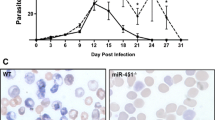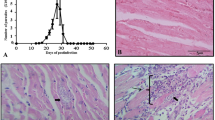Abstract
Increasing evidence critically implicates miRNAs in the pathogenesis of diseases, but little is known in context with infectious diseases. This study investigates as to whether the testosterone-induced persistent susceptibility to blood-stage malaria of Plasmodium chabaudi coincides with changes in miRNA expression of the anti-malaria effectors sites spleen and liver. Female C57BL/6 mice were treated with vehicle or testosterone (T) for 3 weeks. Then, T treatment was discontinued for 12 weeks before challenge with 106 P. chabaudi-parasitized erythrocytes. The miRNA expression was examined after 12 weeks of T withdrawal and during infections at peak parasitemia on day 8 p.i. using miRXplore™ microarray technology. P. chabaudi infections induce an organ-specific response of miRNA expression. We can identify 25 miRNA species to be downregulated by more than 2-fold in the spleen and 169 miRNA species in the liver. Among these 194 miRNA species, there are 12 common miRNA species that are downregulated by 0.48–0.14-fold in both spleen and liver, which are miR-194, miR-192, miR-193A-3P, miR-145, miR-16, miR-99A, miR-99B, miR-15A, miR-152, let-7G, let-7B, and miR-455-3P. Only in the liver, there is an upregulation of the miR-142-5p by 2.5-fold and miR-342-3p by 5.1-fold. After 12 weeks of T withdrawal, the spleen exhibits only the miR-200A that is upregulated by 2.7-fold. In the liver, miR-376B, miR-493*, and miR-188-3P are upregulated by 2.4-fold, 2.2-fold, and 2.1-fold, respectively, and miR-347, miR-200A, and miR-200B are downregulated by approximately 0.4-fold. Upon infection, however, these changes are not sustained, i.e., the miRNA expressions of both spleen and liver of T-pretreated mice exhibit the same response to P. chabaudi malaria as that of vehicle-treated control mice. Our data suggest (1) that the P. chabaudi-induced downregulation of miRNA expression in spleen and liver is required to allow the upregulation of their numerous target genes in response to infection, and (2) that the T-induced persistent susceptibility to P. chabaudi does not affect the responsiveness of miRNA expression in spleen and liver to blood-stage malaria.



Similar content being viewed by others
References
Al-Quarishy S, Delic D, Sies H, Wunderlich F, Abdel-Baki AA, Dkhil MA (2011) Differential miRNA expression in the mouse jejunum during garlic treatment of Eimeria papillata. Parasitol Res 109:387–394
Baltimore D, Boldin MP, O’Connell RM, Rao DS, Taganov KD (2008) MicroRNAs: new regulators of immune cell development and function. Nat Immunol 9:839–845
Bartel DP (2004) MicroRNAs: genomics, biogenesis, mechanism, and function. Cell 116:281–297
Benten WP, Bettenhaeuser U, Wunderlich F, Van Vliet E, Mossmann H (1991) Testosterone-induced abrogation of self-healing of Plasmodium chabaudi malaria in B10 mice: mediation by spleen cells. Infect Immun 59:4486–4490
Benten WP, Ulrich P, Kühn-Velten WN, Vohr HW, Wunderlich F (1997) Testosterone induced susceptibility to Plasmodium chabaudi malaria: persistence after withdrawal of testosterone. J Endocrinol 153:275–281
Bi Y, Liu G, Yang R (2009) MicroRNAs: novel regulators during the immune response. J Cell Physiol 218:467–472
Bilzer M, Roggel F, Gerbes AL (2006) Role of Kupffer cells in host defense and liver disease. Liver Int 26:1175–1186
Bissels U, Wild S, Tomiuk S, Holste A, Hafner M, Tuschl T, Bosio A (2009) Absolute quantification of microRNAs by using a universal reference. RNA 12:2375–2384
Bosman GJ, Willekens FL, Werre JM (2005) Erythrocyte aging: a more than superficial resemblance to apoptosis? Cell Physiol Biochem 16:1–8
Chotivanich K, Udomsangpetch R, McGready R, Proux S, Newton P, Pukrittayakamee S, Looareesuwan S, White NJ (2002) Central role of the spleen in malaria parasite clearance. J Infect Dis 185:1538–1541
Crispe IN (2009) The liver as a lymphoid organ. Annu Rev Immunol 27:147–163
Davidson-Moncada J, Papavasiliou FN, Tam W (2010) MicroRNAs of the immune system: roles in inflammation and cancer. Ann NY Acad Sci 1183:183–194
Delić D, Gailus N, Vohr HW, Dkhil MA, Al-Quraishy S, Wunderlich F (2010a) Testosterone-induced permanent changes of hepatic gene expression sustained during Plasmodium chabaudi malaria. J Mol Endocrinol 45:379–390
Delić D, Grosser C, Dkhil MA, Al-Quraishy S, Wunderlich F (2010b) Testosterone-induced upregulation of miRNAs in the female mouse liver. Steroids 75:988–1004
Delic D, Warskulat U, Borsch E, Al-Qahtani S, Al-Quraishi S, Häussinger D, Wunderlich F (2010) Loss of ability to self-heal malaria upon taurine transporter deletion. Infect Immun 78:1642–1649
Delić D, Dkhil MA, Al-Quraishy S, Wunderlich F (2011) Hepatic miRNA expression reprogrammed by Plasmodium chabaudi malaria. Parasitol Res 108:1111–1121
Garcia LS (2010) Malaria. Clin Lab Med 30:93–129
Griffiths-Jones S, Saini HK, van Dongen S, Enright AJ (2008) miRBase: tools for microRNA genomics. Nucleic Acids Res 36:D154–D158
Haeussinger D, Kubitz R, Reinehr R, Bode JG, Schliess F (2004) Molecular aspects of medicine: from experirnental to clinical hepatology. Mol Aspects Med 25:221–360
Hafalla JC, Silvie O, Matuschewski K (2011) Cell biology and immunology of malaria. Immunol Rev 240:297–316
Harder A, Danneschewski A, Wunderlich F (1994) Genes of the mouse H-2 complex control the efficacy of testosterone to suppress immunity against the intestinal nematode Heterakis spumosa. Parasitol Res 80:446–448
Kamis AB, Ahmad RA, Badrul-Munir MZ (1992) Worm burden and leukocyte response in Angiostrongylus malaysiensis-infected rats: the influence of testosterone. Parasitol Res 78:388–391
Krücken J, Dkhil MA, Braun JV, Schroetel RM, El-Khadragy M, Carmeliet P, Mossmann H, Wunderlich F (2005) Testosterone suppresses protective response of the liver to blood-stage malaria. Infect Immun 73:436–443
Krücken J, Delić D, Pauen H, Wojtalla A, El-Khadragy M, Dkhil MA, Mossmann H, Wunderlich F (2009) Augmented particle trapping and attenuated inflammation in the liver by protective vaccination against Plasmodium chabaudi malaria. Malar J 8:54
Landgraf P, Rusu M, Sheridan R, Sewer A, Iovino N, Aravin A, Pfeffer S, Rice A, Kamphorst AO, Landthaler M, Lin C, Socci ND, Hermida L, Fulci V, Chiaretti S, Foà R, Schliwka J, Fuchs U, Novosel A, Müller RU, Schermer B, BisselsU IJ, Phan Q, Chien M, Weir DB, Choksi R, De Vita G, Frezzetti D, Trompeter HI, Hornung V, Teng G, Hartmann G, Palkovits M, Di Lauro R, Wernet P, Macino G, Rogler CE, Nagle JW, Ju J, Papavasiliou FN, Benzing T, Lichter P, Tam W, Brownstein MJ, Bosio A, Borkhardt A, Russo JJ, Sander C, Zavolan M, Tuschl T (2007) A mammalian microRNA expression atlas based on small RNA library sequencing. Cell 7:1401–1414
Li S, Moffett HF, Lu J, Werner L, Zhang H, Ritz J, Neuberg D, Wucherpfennig KW, Brown JR, Novina CD (2011) MicroRNA expression profiling identifies activated B cell status in chronic lymphocytic leukemia cells. PLoS One 6:e16956
Liu L, Wang L, Zhao Y, Wang Y, Wang Z, Qiao Z (2006) Testosterone attenuates p38 MAPK pathway during Leishmania donovani infection of macrophages. Parasitol Res 99:189–193
Liu Q, Tuo W, Gao H, Zhu XQ (2010) MicroRNAs of parasites: current status and future perspectives. Parasitol Res 107:501–507
Mackinnon MJ, Read AF (2003) The effects of host immunity on virulence-transmissibility relationships in the rodent malaria parasite Plasmodium chabaudi. Parasitology 126:103–112
Mannoor MK, Weerasinghe A, Halder RC, Reza S, Morshed M, Ariyasinghe A, Watanabe H, Sekikawa H, Abo T (2001) Resistance to malarial infection is achieved by the cooperation of NK1.1(+) and NK1.1(−) subsets of intermediate TCR cells which are constituents of innate immunity. Cell Immunol 211:96–104
Mannoor MK, Halder RC, Morshed SR, Ariyasinghe A, Bakir HY, Kawamura H, Watanabe H, Sekikawa H, Abo T (2002) Essential role of extrathymic T cells in protection against malaria. J Immunol 169:301–306
Mehlhorn H (ed) (2008) Encyclopedic reference of parasitology, vol 1, 3rd edn. Springer, Berlin
Murthi P, Kalionis B, Ghabrial H, Dunlop ME, Smallwood RA, Sewell RB (2006) Kupffer cell function during the erythocytic stage of malaria. J Gastroenterol Hepatol 21:313–318
Nobes MS, Ghabrial H, Simms KM, Smallwood RB, Morgan DJ, Sewell RB (2002) Hepatic Kupffer cell phagocytotic function in rats with erythrocytic-stage malaria. J Gastroenterol Hepatol 17:598–605
Novak M, Myal Y, Evans WS (1981) Testosterone propionate and the growth of Hymenolepis microstoma in intact and orichiectomized mice. Parasitol Res 66:113–115
Pawlicki JM, Steitz JA (2010) Nuclear networking fashions pre-messenger RNA and primary microRNA transcripts for function. Trends Cell Biol 20:52–61
Roberts CW, Walker W, Alexander J (2001) Sex-associated hormones and immunity to protozoan parasites. Clin Microbiol Rev 14:476–488
Ronchetti D, Lionetti M, Mosca L, Agnelli L, Andronache A, Fabris S, Deliliers GL, Neri A (2008) An integrative genomic approach reveals coordinated expression of intronic miR-335, miR-342, and miR-561 with deregulated host genes in multiple myeloma. BMC Med Genomics 13:37–45
Ruvkun G (2008) The perfect storm of tiny RNAs. Nat Med 10:1041–1045
Salaun B, Yamamoto T, Badran B, Tsunetsugu-Yokota Y, Roux A, Baitsch L, Rouas R, Fayyad-Kazan H, Baumgaertner P, Devevre E, Ramesh A, Braun M, Speiser D, Autran B, Martiat P, Appay V, Romero P (2011) Differentiation associated regulation of microRNA expression in vivo in human CD8+ T cell subsets. J Transl Med 9:44
Sayed D, Abdellatif M (2011) MicroRNAs in development and disease. Physiol Rev 91:827–887
Schaefer JS, Montufar-Solis D, Vigneswaran N, Klein JR (2011) Selective upregulation of microRNA expression in peripheral blood leukocytes in IL-10−/− mice precedes expression in the colon. J Immunol 187(11):5834–5841
Stephens R, Culleton RL, Lamb TJ (2012) The contribution of Plasmodium chabaudi to our understanding of malaria. Trends Parasitol 28:73–82
Tablin, F. et al. (2002) The microanatomy of the mammalian spleen: mechanisms of splenic clearance in the complete spleen. (Bowdler, A.J., ed.), pp. 11–22, Humana Press
Van der Auwera I, Limame R, van Dam P, Vermeulen PB, Dirix LY, Van Laere SJ (2010) Integrated miRNA and mRNA expression profiling of the inflammatory breast cancer subtype. Br J Cancer 103(4):532–541
Watanabe K, Hamano S, Noda K, Koga M, Tada I (1999) Strongyloides ratti: additive effect of testosterone implantation and carbon injection on the susceptibility of female mice. Parasitol Res 85:522–526
WHO (2010) World malaria report. World health organization, Geneva
Wu H, Neilson JR, Kumar P, Manocha M, Shankar P, Sharp PA, Manjunath N (2007) miRNA profiling of naïve, effector and memory CD8 T cells. PLoS One 2(10):e1020
Wu L, Zhou H, Lin H, Qi J, Zhu C, Gao Z, Wang H (2012) Circulating microRNAs are elevated in plasma from severe pre-eclamptic pregnancies. Reproduction 143(3):389–397
Wunderlich F, Stübig H, Königk E (1982) Development of Plasmodium chabaudi in mice red blood cells: Structural properties of the host and parasites membranes. J Protozool 29:60–66
Wunderlich F, Mossmann H, Helwig M, Schillinger G (1988) Resistance to Plasmodium chabaudi in B10 mice: influence of the H-2 complex and testosterone. Infect Immun 56:2400–2406
Wunderlich F, Marinovski P, Benten WP, Schmitt-Wrede HP, Mossmann H (1991) Testosterone and other gonadal factor(s) restrict the efficacy of genes controlling resistance to Plasmodium chabaudi malaria. Parasite Immunol 13:357–367
Zhang H, Zhao J, Wang P, Qiao Z (2001) Effect of testosterone on Leishmania donovani infection of macrophages. Parasitol Res 87:674–676
Acknowledgments
We are indebted to Dr. Rueberg (Miltenyi, Bergisch-Gladbach, Germany) for help with the microarray hybridizations. This research was supported by King Saud University, National Program for Science and Technology, through a grant no. (10-BIO1212-02).
Author information
Authors and Affiliations
Corresponding author
Electronic supplementary material
Below is the link to the electronic supplementary material.
Fig. S1
Expression levels of hepatic miRNA species of unknown functions downregulated by P. chabaudi malaria. Green color represents downregulation as indicated in the logarithmic color scale bar shown in Fig. 2 (JPEG 458 kb)
Table S1
Liver-specific deregulation of miRNA expression of unknown function induced by P. chabaudi malaria in vehicle-treated control mice (XLSX 16 kb)
Table S2
MicroRNA expression of spleen and liver of T-pretreated and vehicle-treated mice during P. chabaudi malaria on day 8 p.i. (XLSX 12 kb)
Rights and permissions
About this article
Cite this article
Al-Quraishy, S., Dkhil, M.A., Delic, D. et al. Organ-specific testosterone-insensitive response of miRNA expression of C57BL/6 mice to Plasmodium chabaudi malaria. Parasitol Res 111, 1093–1101 (2012). https://doi.org/10.1007/s00436-012-2937-3
Received:
Accepted:
Published:
Issue Date:
DOI: https://doi.org/10.1007/s00436-012-2937-3




